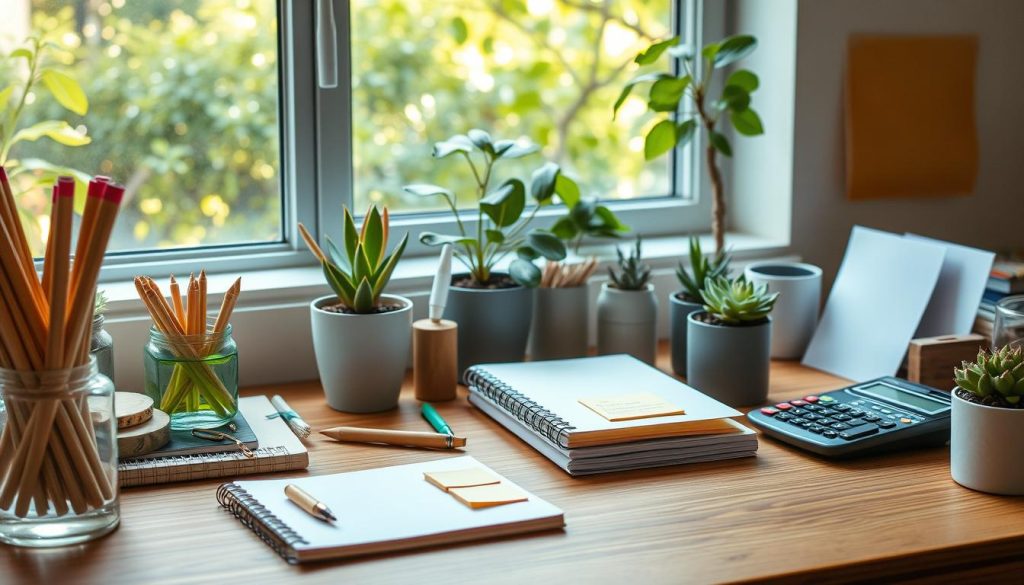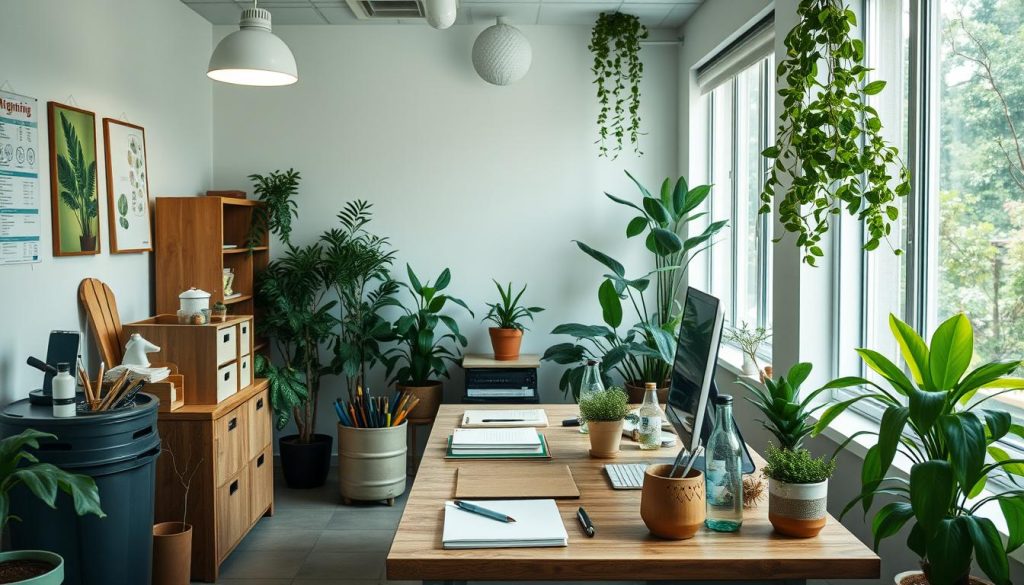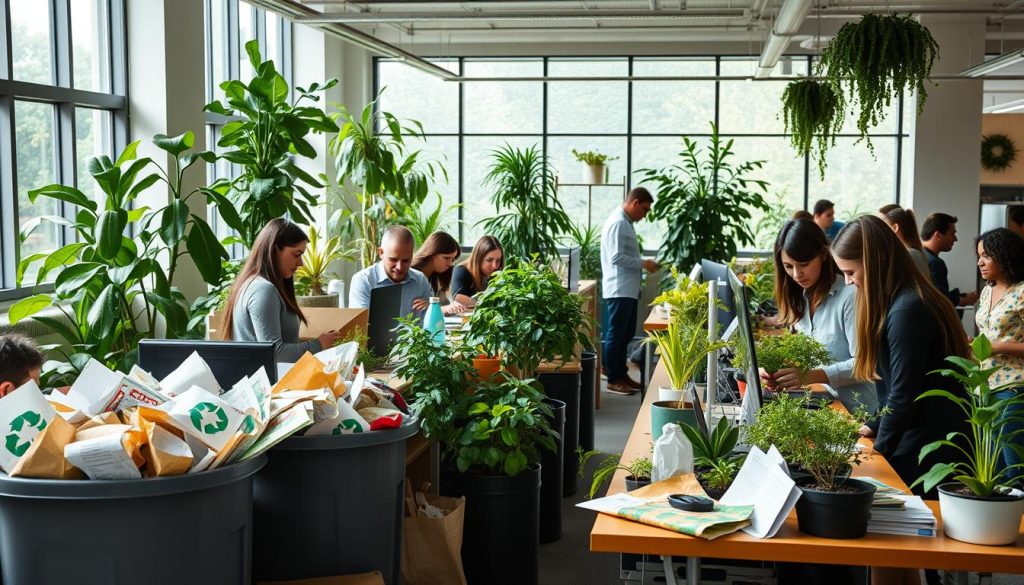I’m excited to share some eco-friendly tips for creating a low waste office. Today, making our workplaces more sustainable is key. By using green practices, we can lessen our environmental impact and make a healthier space for all.
A low waste office is more than just recycling. It’s about changing our daily habits and finding new ways to cut down on waste. We can use paperless solutions and energy-saving practices to make our offices greener.
In this guide, I’ll show you practical ways to make your workspace more sustainable. We’ll look at digital document management and ways to get employees involved. Let’s work together to make a greener future, starting with our offices.
Understanding the Concept of a Low Waste Office
I’m excited to dive into green office solutions and zero-waste initiatives. A low waste office is more than a trend. It’s a smart way to cut down on waste and make a workplace sustainable.
What defines a low waste office?
A low waste office aims to reduce, reuse, and recycle. It uses digital tools, eco-friendly supplies, and manages resources well. These steps help businesses lessen their environmental footprint.
Benefits of implementing eco-friendly practices
Green office solutions bring many benefits:
- Cost savings on supplies and waste management
- Improved company image and employee morale
- Reduced carbon footprint
- Compliance with environmental regulations
Common challenges in transitioning to a sustainable workplace
While the benefits are clear, businesses may face obstacles when starting zero-waste initiatives:
| Challenge | Solution |
|---|---|
| Employee resistance to change | Education and incentive programs |
| Initial investment costs | Long-term cost-benefit analysis |
| Finding sustainable suppliers | Research and networking with eco-friendly vendors |
By knowing these challenges and their solutions, businesses can smoothly move to a low waste office. The path to reducing waste may seem tough, but the long-term gains are worth it.
Assessing Your Current Office Waste
I think the first step to a green office is knowing how much waste you make. A detailed waste audit can show you a lot and help you cut down on waste.
To begin, I gather a team and collect all waste from a normal workday. We sort it into types like paper, plastics, and food. This hands-on method shows us the kinds and amounts of waste we make.
Then, we weigh each type and write down the numbers. This data is our starting point for measuring how much we can improve. I like to make a simple chart:
| Waste Type | Daily Weight (lbs) | Monthly Estimate (lbs) |
|---|---|---|
| Paper | 15 | 300 |
| Plastics | 8 | 160 |
| Food Waste | 12 | 240 |
With this info, I can spot where we can do better and plan ways to reduce waste. For example, if we use a lot of paper, going digital might be a good move.
But remember, a waste audit isn’t just a one-time thing. I suggest doing them often to see how we’re doing and tweak our plans as needed. Keeping up with regular audits is crucial for a green office.
Implementing Paperless Solutions
Switching to paperless office solutions is a big step towards a greener workplace. Digital technologies help us cut down on waste and make work easier.
Digital Document Management Systems
A good digital document system is key for a paperless office. It lets us keep and find files online, without paper. This saves space, cuts down on mess, and keeps documents safe.
E-signatures and Digital Contracts
E-signatures change how we deal with agreements and contracts. They’re legal and cut out the need for printing and scanning. This saves time and paper. Many companies use e-signatures to make deals faster and handle paperwork better.
Cloud-based Collaboration Tools
Cloud tools change how teams work together. They let us work on documents and spreadsheets live. This cuts down on paper and makes work more lively and efficient. It’s good for the planet and boosts our work in the digital age.
Starting these paperless solutions takes some money and training. But the benefits for our business and the planet are huge. As we keep looking for new tech, we find more ways to make our work place better and greener.
Sustainable Office Supplies and Equipment

Choosing eco-friendly office supplies and equipment has changed the game for a greener workplace. By picking sustainable options, we can lessen our environmental impact and stay productive.
Switching to recycled paper products is an easy green office solution. I’ve swapped out regular notebooks for ones made from recycled materials. For printing, I use recycled paper and refillable ink cartridges to cut down on waste.
Energy-efficient equipment is key to eco-friendly practices. I’ve bought ENERGY STAR certified computers, printers, and appliances. They use less power and help lower utility bills.
For furniture, I choose pieces made from sustainable materials like bamboo or reclaimed wood. These are not only durable and stylish but also better for the environment than traditional furniture.
| Traditional Item | Sustainable Alternative | Environmental Benefit |
|---|---|---|
| Plastic pens | Refillable metal pens | Reduces plastic waste |
| Disposable batteries | Rechargeable batteries | Decreases hazardous waste |
| Plastic desk organizers | Bamboo organizers | Biodegradable and renewable |
By choosing sustainable office supplies and equipment, I’ve made my workspace eco-friendly. These small changes have made a big difference in reducing our office’s environmental impact.
Creating an Effective Recycling Program
I think a good recycling program is essential for any office. It helps reduce waste and engages employees. Let’s look at how to set up a system that works well.
Setting up Recycling Stations
To start recycling in offices, place recycling bins in key spots. You’ll need bins for paper, plastic, metal, and glass. Make sure they’re labeled clearly so everyone knows what to do.
Educating Employees on Proper Recycling Practices
Teaching employees is key to a successful recycling program. Use posters or infographics to show what goes in each bin. Also, hold training sessions to teach good recycling habits and fix common mistakes.
Partnering with Local Recycling Facilities
Working with local recycling centers is important. It helps make sure recyclables are handled right. Plus, you can get feedback to make your recycling better.
| Recyclable Item | Bin Color | Processing Method |
|---|---|---|
| Paper | Blue | Pulping and remanufacturing |
| Plastic | Yellow | Sorting, shredding, melting |
| Metal | Red | Melting and recasting |
| Glass | Green | Crushing and melting |
By following these steps, offices can make recycling programs that really work. They help cut down waste and teach employees to care for the environment.
Low Waste Office: Strategies for Minimizing Everyday Waste

Creating a low waste office is simpler than you might think. By focusing on reducing waste, we can make a big difference. Let’s look at some easy ways to cut down on waste in our daily work.
One key way to reduce waste is by getting rid of single-use items. I suggest using reusable cups, plates, and utensils instead. This simple change can greatly lower the trash in break rooms and kitchens.
Setting up recycling and composting stations in common areas is also a smart move. It makes it easy for employees to throw away waste the right way. This helps build a culture of sustainability.
- Use refillable water bottles instead of plastic bottles
- Opt for digital note-taking apps rather than paper notebooks
- Choose rechargeable batteries over disposable ones
- Implement a “bring your own lunch” policy to reduce takeout container waste
By using these strategies, we can make our workplace more eco-friendly. Remember, every small step helps in reducing waste and building a sustainable future.
Energy-Efficient Practices for a Greener Workplace
I’m excited to share some energy-efficient practices that can transform your office into an environmentally conscious space. By implementing these strategies, you’ll create a sustainable workplace that’s both cost-effective and eco-friendly.
Smart Lighting Solutions
Switching to LED bulbs and installing motion sensors can significantly reduce energy consumption. In my experience, smart lighting systems that adjust based on natural light levels have made a big difference in office energy use.
Energy-Saving Computer Settings
Configuring computers to enter sleep mode when inactive and using power strips for easy shutdown can cut energy waste. I’ve found that educating employees about these simple settings creates a more sustainable workplace culture.
HVAC Optimization
Proper HVAC maintenance and programmable thermostats are key to energy efficiency. In my environmentally conscious office, we’ve seen substantial savings by adjusting temperatures during off-hours and ensuring regular system check-ups.
| Energy-Saving Practice | Potential Annual Savings | Implementation Difficulty |
|---|---|---|
| LED Lighting | 30-50% on lighting costs | Easy |
| Computer Power Management | $50 per computer | Easy |
| HVAC Optimization | 10-30% on heating/cooling costs | Moderate |
By adopting these practices, you’ll be well on your way to creating an energy-efficient, sustainable workplace that benefits both the environment and your bottom line.
Encouraging Employee Participation in Eco-Friendly Initiatives

To make a workplace sustainable, everyone needs to get involved. Engaging employees in green practices is essential. Let’s look at some ways to increase participation and make your office more eco-friendly.
Setting up green teams is a strong strategy. These teams of eager employees can lead in making your workplace greener. They come up with ideas, plan events, and motivate others to join in.
Running sustainability challenges is another effective method. Offices can hold competitions to cut down energy use or reduce single-use plastics. These contests are fun and help build a sense of teamwork while promoting green habits.
Incentives can also encourage employees to be more eco-friendly. You could offer rewards for those who consistently use sustainable practices. For example:
- Extra vacation days for top recyclers
- Gift cards for those who bike or carpool to work
- Recognition in company newsletters for innovative green ideas
Teaching employees about sustainability is also important. Holding workshops and seminars can help them understand why it matters. They can learn about recycling, saving energy, and reducing waste at home.
Creating a sustainable workplace is a long-term effort. By involving your team, you’ll build a culture of caring for the environment. This culture will spread beyond your office.
Measuring and Tracking Your Office’s Waste Reduction Progress
Measuring and tracking waste reduction is key for a low waste office. It’s not just about starting strategies; it’s about seeing if they work. Let’s explore how to monitor our eco-friendly efforts well.
I set clear, measurable goals first. For example, I aim to cut paper use by 50% or reduce overall waste by 30% in six months. These goals give us a clear target to aim for.
Then, I establish a baseline. This means tracking waste levels before starting new strategies. It’s like taking a “before” photo in a weight loss journey.
Regular monitoring is crucial. I use a simple spreadsheet to track waste output weekly or monthly. This helps spot trends and areas for betterment. Here’s how I track progress:
| Waste Type | Baseline (lbs/month) | Month 1 | Month 2 | Month 3 |
|---|---|---|---|---|
| Paper | 500 | 400 | 350 | 300 |
| Plastic | 200 | 180 | 150 | 120 |
| Food Waste | 300 | 250 | 200 | 180 |
This data helps me tweak our low waste office strategies. If we’re not hitting targets in some areas, I adjust our plan. It’s all about ongoing improvement in our waste reduction journey.
The Future of Low Waste Offices: Emerging Trends and Technologies
I’m excited about the future of green office solutions! Smart waste management systems are coming. They use sensors to track waste levels and schedule collections. This makes recycling more efficient than ever.
AI-powered recycling is another big change for sustainable workplaces. It can sort different materials with amazing accuracy. This technology will increase recycling rates and reduce waste, making our efforts more effective.
Circular economy principles are changing office environments too. Companies are designing products with their whole lifecycle in mind. From furniture made from recycled materials to electronics designed for easy repair, these innovations help create low-waste offices.
To stay ahead in sustainable workplace practices, keep an eye on these trends. By using new technologies and innovative approaches, we can make greener, more efficient offices. These offices will benefit both our businesses and the planet.

